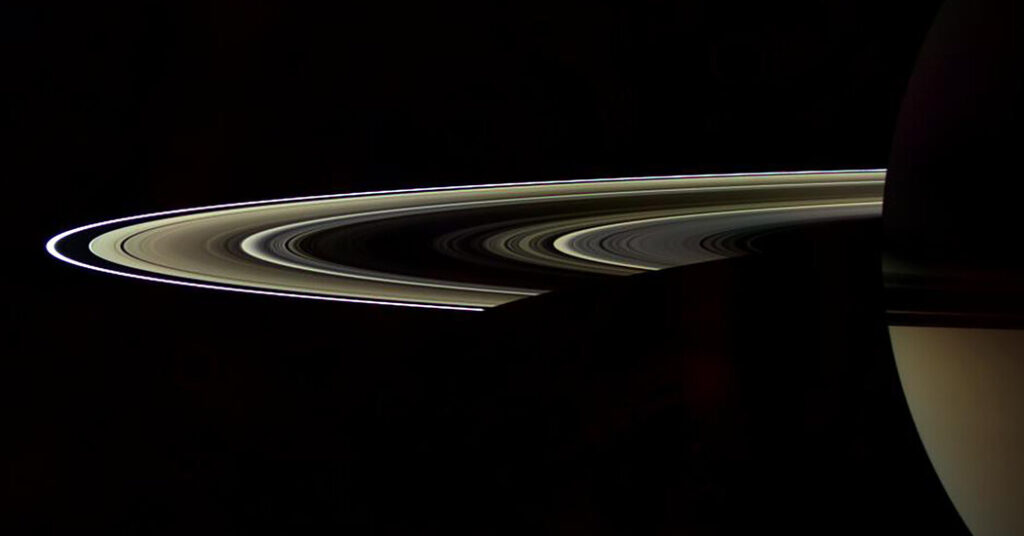If you head into your backyard this weekend and set up your telescope, the giant planet Saturn will be there for you to see.
“Saturn is a spectacular object to look at,” said Damian Peach, an English astrophotographer who frequently observes the giant planet. “Even with small telescopes, you can see the rings.”
But something won’t look right: The famous rings will be all but invisible. That’s because Earth and Saturn seem to be aligning in what astronomers call a ring-plane crossing. During these events, the ultrathin rings are exactly edge-on to Earth and effectively disappear.
For this weekend’s event, the crossing will not be complete: Saturn’s rings will appear to narrow to less than 1 percent visible on Saturday before the orbital motions of the two worlds make them appear to widen out again.
While the vanishing will not be total, it could be a rare chance to take in such an event: The next opportunity to see a complete crossing will be in 2038, Mr. Peach said.
Why the Rings Seem to Vanish
The effect occurs because Saturn is tilted on its axis, like Earth (although Saturn takes almost 30 years to circle the sun). The orbits of both planets make Saturn’s rings appear from Earth to widen, narrow and then vanish during ring-plane crossings.
The crossings occur in groups every 13 to 16 years, but they are not always visible. Saturday’s near crossing follows a complete ring-plane crossing in March, but Saturn was blotted out then by the glare of the sun and could not be observed. A single crossing in 2009 was impossible to see for the same reason, and the last three observed from Earth were in 1995 and 1996.
Ring History
The rings’ disappearing trick caused confusion when Saturn was first observed through a telescope over 400 years ago.
Michael Shank, an emeritus professor of history at the University of Wisconsin-Madison, said in an email that Galileo Galilei observed Saturn in July 1610 with a “spyglass” he had made himself. But he was perplexed because his primitive telescope couldn’t properly resolve the rings — and because nobody back then suspected planets could have rings.
Galileo concluded that what he had seen were “lateral bodies,” one attached to each side of Saturn itself. He had observed “the highest planet, triple-bodied,” he wrote in code to Johannes Kepler, meaning he had observed Saturn (the farthest or “highest” known planet) and seen that it comprised three objects. (Kepler failed to decipher Galileo’s code correctly, however. He supposed instead that it meant that Mars had two moons, a guess that, centuries later, turned out to be correct.)
Galileo was even more perplexed when he observed Saturn a few years later. His “triple-bodied” planet had become one because the rings at that time were edge-on and invisible in his telescope. A few years later still, however, and Saturn’s rings were visible again. But this time they looked different, so Galileo reasoned they might be “ears” of some sort.
This confusion lasted until 1659, when the astronomer Christiaan Huygens proposed that what Galileo had seen were actually rings — the first ever found and still the most impressive, although other planets are now known to have much smaller rings.
E.C. Krupp, who has studied the 1990s ring-plane crossings and is the director of the Griffith Observatory in Los Angeles, said Galileo did his best with the instruments at hand.
“It was really a marvel he observed as much as he did,” he said.
Some Saturn Science
Philip Nicholson, an astrophysicist at Cornell University, and his colleagues will use the James Webb Space Telescope to observe Saturday’s near crossing. Most of Saturn’s rings are almost invisible from Earth during a ring-plane crossing, but the lack of glare means it is the best time to study the outermost and very faint e-ring, which scientists think is generated by plumes of ice from Saturn’s moon Enceladus.
The team will use the near crossing to study light reflected from the vaporous e-ring, with the hope of detecting carbon atoms. That would strengthen the case for habitability in the underground ocean beneath the icy crust of Enceladus, Dr. Nicholson said.
When to Watch
Saturn will be prominent in the southeastern sky after sunset on Friday, Saturday and Sunday. You’ll want to observe it before about 3:30 a.m. local time, when it sets from the night sky.
The moment the rings look narrowest will be at 7 p.m. Eastern on Saturday, about an hour after Saturn rises, but they are almost edge-on to Earth already and look much the same.
Saturn’s rings will slowly get wider again over the coming months, reaching their greatest apparent width in late 2027.
The post Why the Rings of Saturn Seem as if They’re About to Disappear appeared first on New York Times.




